
Please note: Mallorca has ongoing access issues. Read our recent article before you go.
Mallorca is an island with high limestone mountains and massive sea cliffs. Traditional climbing on Mallorca goes back a very long way. It mostly took place in the mountains, which are like the Eastern Alps on a smaller scale, but unlike the Alps they can offer good rock climbing conditions all the year round. Nowadays it is very difficult to get any information about the traditional climbing and mountaineering on Mallorca - the brash dominance of sport climbing seems to have banished it into obscurity. All the modern guidebooks are sport climbing guides and the long history of Mallorcan mountaineering is fast being forgotten - but traditional climbing is where the real adventure lies and it could still have a bright future on Mallorca.
The potential for trad on the bigger mountain crags and the sea cliffs is huge and so far the relatively few devotees have barely scratched the surface. It is my hope that others will help dispel the scurrilous myth which holds that climbing on Spanish limestone inevitably requires drilling the rock.
Back in March of 2004, Steve Sustad and I had an unusual climbing trip to this paradise of Spanish sport climbing - unusual in that we never clipped a bolt. It was my third visit. On the first two I clipped bolts with the best of them, but as I popped up and down various 20-metre sections of rock to the lower-off chains, I couldn't help questioning what I was doing when all over the island there appeared to be massive crags waiting to be explored. So this time a very different trip took shape. On the downside the sacks were a lot heavier – double ropes, abseil rope and a full rack – but on the plus side every route was a powerful experience rich with memories, unlike many of the ones done on earlier visits.
In mid-March we were perhaps a little early in the year. Everything was shut or half-deserted and in the Formentor area we couldn't get a boat for love nor money. Formentor - where the cliffs drop sheer for 350m to the sea and extend for miles. Even the sport climbers go to gawp. It was chilly and breezy so we looked for a mission on the south side of the peninsula and stumbled on a 600 foot cliff not far from the lighthouse on the tip. The route started innocuously enough then led out beneath a massive slanting roof until a space-walking pitch – heel hooking out over 500ft of thin air – took us around the lip to another excellent pitch on the headwall. We called the route Full English (E4 5c) after the style of ascent and the breakfast most beloved of the Spanish 'costas'.
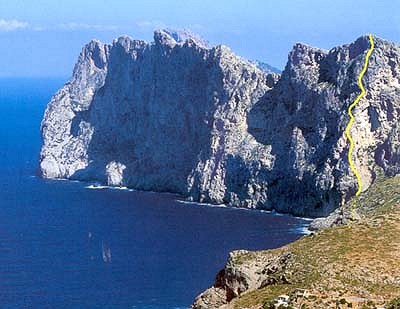
Our next objective was to find a route somewhere on the giant north-facing cliffs of the Formentor Peninsula. After investigation we found that the most impressive bits of rock could only be reached by boat, and having no luck getting one we decided to try the precipice which drops to the sea from the Cavall Bernat ridge (a famous mountaineering scramble near Port de Pollença) as it can be approached along the foreshore. On the day of our attempt it was blowing a gale from the west with thick cloud obscuring the top of the cliff. We made an 'alpine start' at first light from Cala San Vicente, crossing grass and boulder slopes to reach the base of the crag in about an hour. We had hoped to traverse some way along the foot of the cliff, but this was clearly impassable so we had to take the first of the major buttresses. The route started with three or four pitches of VS territory made more challenging by the vicious, buffeting wind. "This is beginning to remind me why I gave up mountaineering", Steve observed.
As we got into the day it warmed up a little and the wind dropped in time for some harder pitches. We began to enjoy the feeling of being committed on a big cliff. The route was 'exploratory' rather than classic but hinted at great possibilities for the future. We topped out at 6pm and it was dark by the time we got off the ridge.
The balmier climate of the south coast beckoned and next day saw us sipping cocktails on the roof garden of a friend's apartment in Port de Andratx. We hadn't expected much in the way of crags down here - this was to be the laid-back part of the trip – however a couple of hours exploring revealed cliffs up to 200m right on our doorstep. Most were south-facing and the rock was clean and solid. Beside Port de Andratx the headland of La Mola is ringed by at least a mile of vertical limestone over 100m high. God knows how many routes it would give if it were in Britain, but we contented ourselves with one - a nice four-pitch E2. The most amazing trip here would be the sea-level traverse, a gargantuan undertaking. We skipped it because a) the sea was too cold, and b) Steve can't swim - but what a day out it would give in September/October.
Across the bay from La Mola stands a headland more than twice as high – the Cap de Llamp. The tip forms a true sea cliff 220m high, while around to the north-west, the side overlooking Cala Llamp, the cliff takes the form of a high tier with a driveable track beneath. Though we'd really come to climb the sea cliffs, it's not every day you can drive to the bottom of an unclimbed 500ft crag, so it had to be attempted. We got halfway up one afternoon, finding it hard going because of slick white lichen which coated much of the rock, then backed off leaving all our kit behind so that we couldn't wimp out of finishing the line. The top 3 pitches were all 5c (E4) and dramatic, taking a series of big groove features. Like most of the routes we did on this trip, this climb was 'exploratory' – even better and harder lines await. We called it Malovista as unfortunately it overlooks one of the uglier developments on the Spanish coastline, a hillside covered in 'luxury' apartments which look more like catacombs.
We had time for one last route and it had to be something on the tip of Cala Llamp. To get there involved a hike along a private road past some seriously exclusive residences (Claudia Schiffer has a place here somewhere) so we were glad to be well out of season when the whole area seemed deserted. A convenient gully line got us down to the base of the wall. Steve suggested climbing leftwards up a nice-looking rib but I thought that would be avoiding the main challenge of the cliff and insisted that we traverse left for a rope length into the impressive central bay. A superb groove line led up from here and for a while, I felt vindicated, but unfortunately, I couldn't get up it. It was still early in the day and the rock was a touch greasy – that was my excuse. It would go at E6 if bone dry. So I kept heading left on a rising traverse, reaching a stance with a poor belay after 60m. Steve was a third of the way along the pitch when a handhold broke sending him on a 10-metre pendulum which ended with him thumping into the side of a groove. The shock load lifted me off my stance and out over the void, where I hung suspended from two dodgy nuts looking down 120ft of vertical rock to the sea below. By the time Steve joined me his left elbow and forearm had swelled up and it was clear he wouldn't be leading.
The next pitch proved more friendly – very rough, solid limestone and with heat like the best British summer bringing out the scent of plants on the ledges and taking me back to early days of pioneering in Torbay. Then the rock turned very compact and a 6a pitch with terrible protection banished all daydreaming and gave the hardest lead of the holiday. Above this we wandered up the easiest line on the final tower, with pleasant 4c climbing. With one pitch being much harder than the others it was clear that once again we hadn't picked the plum line, but Fall from Grace (E4 6a) had given us a sporting day out and brought to light exciting future projects.
The upshot of the week was that, unless purely for fitness training, I wouldn't dream of taking another climbing trip to Mallorca without a full trad rack. The scope on both the sea cliffs and the inland faces is vast, and the satisfaction of doing climbs which follow strong natural lines, and of climbing in a style which leaves the rock as you found it, more than compensates for any extra effort involved.
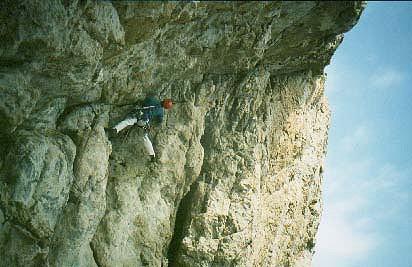
Postscript. Exactly ten years after our trip, the Spanish team of Ricard Darder and Adria Chueca established two more big trad routes on Formentor, operating from a boat. One took a relatively easy weakness and gave an 8-pitch IV+; one hell of a setting for a route of that standard. The other took one of the most continuous compact faces on the peninsula – Set de Sal is a true big-wall free climb giving 540m of sustained climbing with sustained difficulties of 6a-6c+, making it E4/5 in UK trad grades. This must be one of the biggest and best limestone trad routes in Europe, and it points to a great future for trad climbing in Mallorca.
Logistics
When to Go
The climbing season runs from late September to May. During this time if you pick the orientation and elevation of crags carefully the air temperature is usually ideal although in the depths of winter the mountain crags can be cold and Santanyi and Cala Magraner will be unbelievably hot on sunny days. Rainfall is not as low as on the mainland and at times can be persistent especially in the vicinity of the mountains to the north. After heavy rains seepage will affect some lines although the rock itself dries very quickly. Summer is very hot although the shady mountain crags will offer some possibilities.
Flights and Cars
Palma is the main airport on the island and is the third-largest airport in Spain so it accommodates flights from all over the world. The airport is home to a large number of car hire companies on site but it is always advisable to book ahead.
Accommodation Advertise here
No Premier Listings found in this area
There are many options all over Mallorca that range from small apartments to huge Villas. Palma itself is a very lively place and would suit those looking for a full nightlife. Soller is a quiet spot out of season. Puerto Pollensa is a very nice small coastal resort that has bars and restaurants that are open out of season. The resorts on the southeast coast are a long way from the bulk of the climbing areas and can be very quiet out of season.
Food
Food on Mallorca is very easily obtained from the numerous shops and supermarkets that are located in virtually all of the island's towns. All tastes are catered for in the resorts although Mallorcan prices are generally higher than on mainland Spain. Restaurants on the smaller villages are likely to be shut on Mondays.
Outdoor Shops Advertise here
No Premier Listings found in this area
There is a gear shop in Palma and a small outlet in Port d'Pollenca.
Instructor/Guides Advertise here
No Premier Listings found in this area
Other Activities
The beaches on Mallorca are legendary and the mountains are brilliant for walking. Road biking is extremely popular. The city of Palma is a very interesting place to visit whilst Soller has some good cafes.






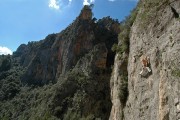
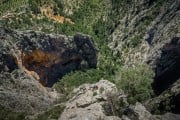



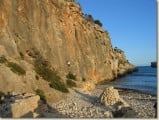

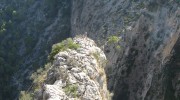
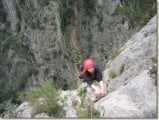











Comments
It's a bit of a relief to see this. When on a family holiday there a few years ago we took a trip to the Formentor lighthouse and the potential was just staggering. We did see a couple of rusted bolts just shy of the top so there must be some climbing already around there, but I couldn't find much record of it anywhere.
Yes, my thoughts as well when I visited about 25 years ago. It certainly looked like a boat would be required to reach any possible climbs. Interesting to see if the inland crags have had much trad development.
Is this article sort a of re-run of something I presume Pat must have written for one of the magazines back closer to the time when he did those routes? I did the Cavall Bernat ridge in two halfs on two different trips to Mallorca ,split by quite a few years, but the first time we went, maybe 12 years ago now, I somehow knew that a British team had done routes somewhere on the face below us - so it must have been something I had read in the magazines.
It's an interesting article but it feels a bit "orphaned". Pat and Steve did their routes 15 years ago and then the postscript mentions more trad routes being done by a (Spanish?) team, 5 years ago. Why the article now? Has any other trad climbing been recorded there in the last half a decade?